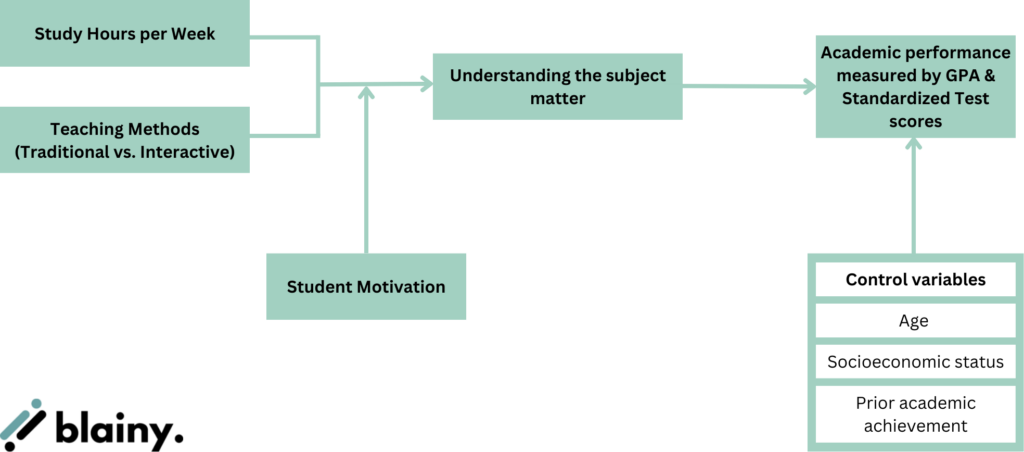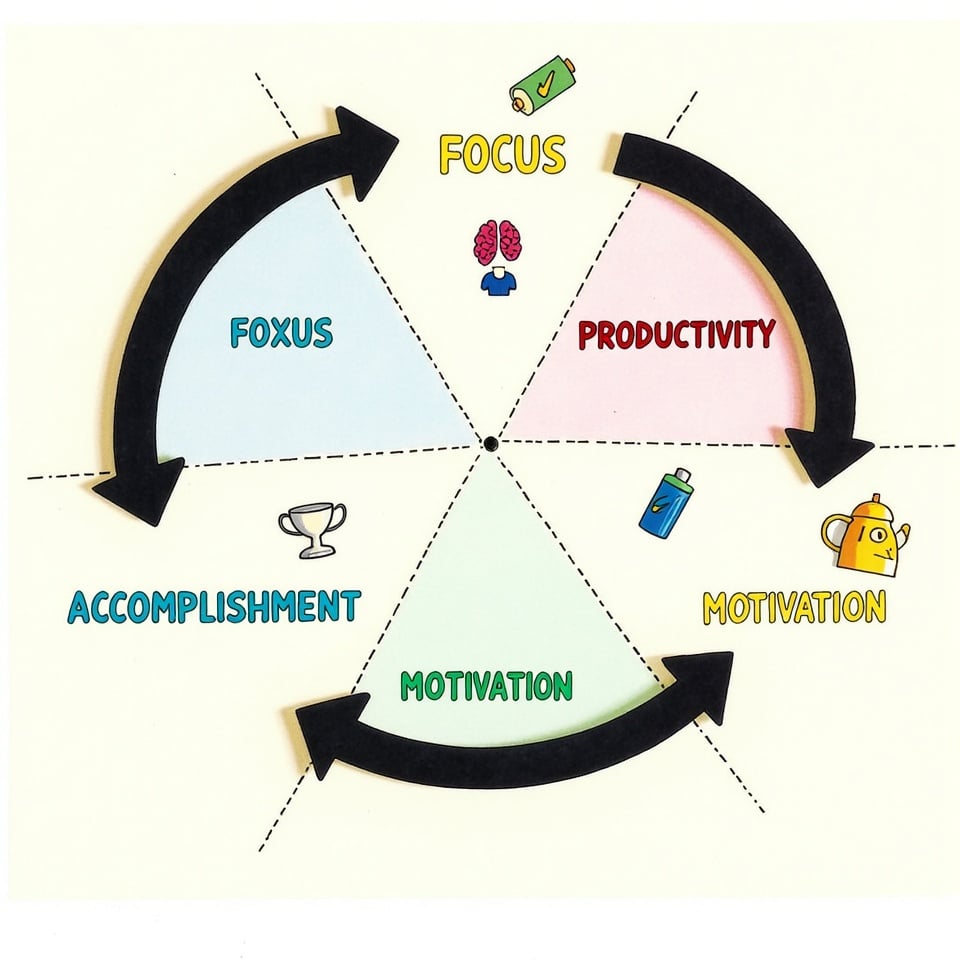In academic research, conceptual frameworks serve as essential blueprints, guiding scholars through the complex landscape of their studies. This article will explore how to construct powerful conceptual frameworks that elevate research design and execution.
Whether a seasoned researcher or new to academia, you’ll learn to craft frameworks that clarify objectives, map relationships between variables, and provide a solid foundation for data collection and analysis.
Ready to transform your approach to research design?
Let’s explore the critical role of conceptual frameworks in shaping successful research projects!
Table of Contents
Definition of a conceptual framework
A conceptual framework is a structured approach to organizing and presenting the key ideas, theories, and relationships that underpin a research study or academic argument.
It serves as a roadmap for the researcher, guiding the investigation and helping to connect various concepts logically and coherently.
For example, in a study examining the factors influencing student academic performance, a conceptual framework might include concepts such as socioeconomic status, parental involvement, teacher quality, and school resources. The framework would illustrate how these factors are thought to interact and influence the outcome of academic performance.
Developing conceptual framework in research
Developing a conceptual framework is a crucial step in the research process that helps researchers organize their thoughts, identify key variables, and visualize the relationships between different concepts in their study.
This process involves synthesizing existing literature, personal observations, and theoretical knowledge to create a structured representation of the research problem and its potential solutions.
A well-crafted conceptual framework serves as a roadmap for the entire research project, guiding the researcher through data collection, analysis, and interpretation.
It also helps in communicating complex ideas to readers, making the research more accessible and understandable.
By clearly defining the key concepts and their interconnections, researchers can ensure that their study remains focused and coherent throughout its execution.
Developing a conceptual framework is an iterative process that often evolves as the research progresses. It requires critical thinking, creativity, and a deep understanding of the subject matter. Researchers must be prepared to revise and refine their framework as they gain new insights or encounter unexpected findings during their study.
Creating a conceptual framework not only benefits the researcher but also adds credibility to the research by demonstrating a thoughtful and systematic approach to addressing the research question. It helps in identifying potential gaps in existing knowledge and can highlight areas where the study may contribute to the broader field of research.
Here’s a step-by-step guide can create a conceptual framework.
Related reading: How to write a research proposal
Step#1: Select your research question
Selecting a research question is the crucial first step in developing a conceptual framework. This step lays the foundation for your entire research project and guides the development of your conceptual framework.
Here’s a detailed explanation of this step:
The research question is the central inquiry that your study aims to answer. It should be clear, focused, and relevant to your field of study. When selecting your research question:
1. Identify your area of interest:
Begin by considering topics that genuinely interest you within your field. This ensures that you’ll remain motivated throughout the research process.
2. Review existing literature:
Conduct a preliminary literature review to understand what’s already known about your topic and identify gaps in current knowledge.
3. Consider relevance and significance:
Ensure that your question addresses a meaningful issue or problem in your field. It should contribute to existing knowledge or have practical implications.
4. Assess feasibility:
Consider whether you have access to the necessary resources, data, and time to answer the question effectively.
5. Be specific:
Narrow down your question to make it manageable. Avoid overly broad or vague questions that could lead to unfocused research.
6. Formulate the question:
Craft your question using clear, concise language. It should be open-ended enough to allow for in-depth exploration but specific enough to guide your research.
7. Test your question:
Ask yourself if the question can be researched, analyzed, and potentially answered within the scope of your study.
For example, instead of a broad question like “How does social media affect teenagers?”, you might refine it to “How does daily Instagram use impact self-esteem in female high school students aged 14-18 in urban areas?”
Step#2: Select and define your independent and dependent variables
This step is crucial in developing your conceptual framework as it helps clarify the relationships you’ll be exploring in your research. Let’s break down each component:
Independent Variables:
These are the factors you manipulate or control in your study. They are presumed to cause or influence the dependent variable. In your conceptual framework, independent variables are typically positioned on the left or at the beginning of your model.
For example, in a study on academic performance, independent variables might include:
- Study hours per week
- Teaching methods
- Class size
Dependent Variables:
These are the outcomes or effects you’re measuring in your study. They are influenced by the independent variables. In your conceptual framework, dependent variables are usually positioned on the right or at the end of your model.
Using the same example, the dependent variable might be:
- Student grades
- Test scores
Moderator Variables:
These are variables that affect the strength or direction of the relationship between independent and dependent variables. They can amplify or diminish the effect of the independent variable on the dependent variable.
For instance, a moderator in our academic performance study could be:
- Student motivation level
Mediator Variables:
These variables explain how or why an independent variable affects the dependent variable. They serve as a link in the causal chain between the independent and dependent variables.
An example of a mediator in our study might be:
- Student engagement level
Moderator vs. Mediator:
The key difference is that moderators affect the strength of the relationship, while mediators explain the process through which the independent variable influences the dependent variable.
Control Variables:
These are variables that you hold constant or control for in your study to ensure that they don’t interfere with the relationship between your main variables of interest. They help isolate the effects of your independent variables on the dependent variables.
In our academic performance example, control variables might include:
- Age
- Socioeconomic status
- Prior academic achievement
When selecting and defining these variables:
- Ensure they are related to your research question.
- Choose variables that can be measured or observed.
- Consider how these variables interact with each other.
- Be precise in your definitions to avoid ambiguity.
Related reading: How to find research articles
Step#3: Determine your cause-and-effect relationship
Determining the cause-and-effect relationship is a critical step in developing your conceptual framework. This step involves identifying and clarifying how your independent variables (causes) are expected to influence your dependent variables (effects).
Here’s a detailed explanation of this step:
1. Identify potential causal relationships:
Based on your research question and the variables you’ve selected, hypothesize how your independent variables might affect your dependent variables. Consider both direct and indirect relationships.
2. Review existing theories and literature:
Examine established theories and previous research in your field to support your hypothesized relationships. This helps ground your framework in existing knowledge and can provide insights into potential causal mechanisms.
3. Consider the direction of relationships:
Determine whether the relationships are positive (as one variable increases, the other increases) or negative (as one variable increases, the other decreases).
4. Account for complexity:
Recognize that cause-and-effect relationships in social sciences are often complex. Multiple causes might lead to a single effect, or a single cause might have multiple effects.
5. Consider time factors:
Think about whether the effects are immediate or if there’s a time lag between the cause and the effect. This is particularly important in longitudinal studies.
6. Examine potential mediators and moderators:
Consider how mediator variables might explain the mechanism of the cause-effect relationship, and how moderator variables might influence the strength or direction of these relationships.
7. Be aware of spurious relationships:
Consider whether any apparent cause-effect relationships might be due to other, unmeasured variables. This is where your control variables become important.
8. Use logical reasoning:
Ensure that your proposed cause-effect relationships make logical sense and can be explained theoretically.
9. Consider alternative explanations:
Think critically about other possible explanations for the relationships you’re proposing. This helps in developing a more robust framework.
10. Visualize the relationships:
Start sketching out how these cause-and-effect relationships might look in a diagram. This can help you see potential gaps or inconsistencies in your logic.
Example:
- In our academic performance study, we might hypothesize that:
- Increased study hours (independent variable) lead to improved grades (dependent variable).
- This relationship might be mediated by an improved understanding of the subject matter.
- The relationship might be moderated by student motivation, where highly motivated students see a stronger effect of study hours on grades.
- Teaching methods (another independent variable) might also influence grades, possibly through increased student engagement.
Remember, at this stage, you’re proposing these relationships based on theory and prior research. Your actual study will test these proposed cause-and-effect relationships. Be prepared to revise your framework if your findings don’t support your initial hypotheses.
Example of a conceptual framework
An example of a conceptual framework can help illustrate how all the elements we’ve discussed come together.
Let’s use our academic performance study to create a sample conceptual framework.
Research Question:
“How do study hours and teaching methods affect high school students’ academic performance, and what role does student motivation play in this relationship?”
Conceptual Framework Example:

Explanation of the framework:
1. Independent Variables:
- Study Hours per Week
- Teaching Methods (Traditional vs. Interactive)
2. Dependent Variable:
- Academic Performance (measured by GPA and Standardized Test Scores)
3. Mediator:
- Understanding of Subject Matter (explains how study hours and teaching methods affect performance)
4. Moderator:
- Student Motivation (affects the strength of the relationship between independent and dependent variables)
5. Control Variables:
- Age
- Socioeconomic Status
- Prior Academic Achievement
Proposed Relationships:
- Increased study hours are expected to lead to better academic performance.
- Interactive teaching methods are hypothesized to result in higher academic performance compared to traditional methods.
- The effect of study hours and teaching methods on academic performance is mediated by the student’s understanding of the subject matter.
- Student motivation moderates these relationships. For highly motivated students, the positive effects of study hours and interactive teaching methods on academic performance are expected to be stronger.
- The control variables are held constant to isolate the effects of the main variables of interest.
This conceptual framework visually represents the hypothesized relationships between variables.
It shows how study hours and teaching methods (independent variables) are expected to influence academic performance (dependent variable), with the understanding of the subject matter as a mediator.
Student motivation serves as a moderator, potentially affecting the strength of these relationships.
The framework also acknowledges the presence of control variables, which are important for the study but not the primary focus of the research question.
Conclusion
Developing a conceptual framework is a critical step in research, providing structure and clarity to complex investigations. This article has outlined key steps in creating robust frameworks, emphasizing variable selection, relationship determination, and visual representation.
A well-constructed framework, as illustrated in our academic performance example, integrates various elements into a comprehensive model.
It’s important to remember that conceptual frameworks are dynamic, evolving with new insights.
Ultimately, they serve as invaluable tools, guiding research processes and effectively communicating ideas, thus forming a solid foundation for knowledge advancement in any field.
Frequently asked questions
What is a conceptual framework in research?
A conceptual framework in research is a structured approach to organizing and presenting the theoretical and conceptual underpinnings of a study. It visually or narratively explains the main variables, concepts, or constructs in a research project and how they are expected to relate to one another. Essentially, it’s a researcher’s map of the territory they plan to explore, showing the anticipated relationships between key elements of their study.
What are the 3 components of conceptual framework in research?
The three main components of a conceptual framework in research are:
- Variables: These include independent variables (factors that influence outcomes), dependent variables (outcomes being studied), and potentially mediating or moderating variables.
- Relationships: This component describes how the variables are expected to interact or influence each other, often based on existing theories or previous research.
- Context: This includes the broader theoretical background, assumptions, and limitations that frame the study and help explain why certain variables and relationships are being examined.
What are the three main types of conceptual frameworks for research?
The three main types of conceptual frameworks in research are:
- Descriptive Frameworks: These aim to identify, define, and describe the key concepts or variables in a study without necessarily proposing specific relationships between them.
- Explanatory Frameworks: These go beyond description to propose and explain relationships between variables, often drawing on existing theories to predict how and why certain factors influence outcomes.
- Predictive Frameworks: These frameworks not only describe and explain relationships but also aim to predict outcomes based on specific conditions or interventions.
What is the difference between theoretical and conceptual frameworks?
Theoretical and conceptual frameworks serve different roles in research. A theoretical framework focuses on existing theories relevant to the research topic, providing a broader context for understanding the problem. It draws from multiple theories to explain phenomena and positions the study within the larger body of knowledge in the field.
A conceptual framework, however, is specific to the particular study being conducted. It identifies and defines the key variables and concepts in the study, showing how these variables are expected to relate to each other. While it often incorporates elements from the theoretical framework, it applies them to the specific research context.
The conceptual framework is more practical, serving as a roadmap for the study by guiding data collection, analysis, and interpretation. It helps researchers visualize relationships between variables and clarify their hypotheses, bridging the gap between broad theories and the practical aspects of the research.







